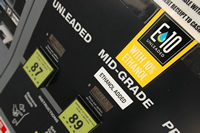By Benjamin Didier
US~Observer Exclusive
 Each year I drive my car to work and back, I starve approximately 80 people around the United States. So do you. In addition to this, every time I race my car at the drag strip, I expend about a quarter of the food that the average human eats in a year, and assuming I race about 30 times a year, the total comes out to about 88 peoples’ supply of sustenance I put into my gas tank annually. If you’re wondering how I could be so cruel, the answer comes from a little alcoholic intruder in our gasoline called ethanol. Ethanol can be made from a number of sugary food sources, such as beets, sweet potatoes, or most commonly, the “vampire crop” corn. While the statement of starving so many people is somewhat of an exaggeration (being that very few humans could stand to live solely off of these crops), it still brings home the fact that mixing ethanol into our fuel is having a huge negative impact on national and international food supplies.
Each year I drive my car to work and back, I starve approximately 80 people around the United States. So do you. In addition to this, every time I race my car at the drag strip, I expend about a quarter of the food that the average human eats in a year, and assuming I race about 30 times a year, the total comes out to about 88 peoples’ supply of sustenance I put into my gas tank annually. If you’re wondering how I could be so cruel, the answer comes from a little alcoholic intruder in our gasoline called ethanol. Ethanol can be made from a number of sugary food sources, such as beets, sweet potatoes, or most commonly, the “vampire crop” corn. While the statement of starving so many people is somewhat of an exaggeration (being that very few humans could stand to live solely off of these crops), it still brings home the fact that mixing ethanol into our fuel is having a huge negative impact on national and international food supplies.
Granted, there is a large following that favors the use of ethanol to help decrease the amount of fossil fuels that the U.S. must use. They also believe it will help to ease the impact that petroleum has on the environment. After all, our fuel, which currently is made up of a mixture of ten percent ethanol to ninety percent gasoline, does produce a modest decrease in the emissions of carbon dioxide, a greenhouse gas, when compared to straight petroleum. It also doesn’t require drilling into the earth to access like crude oil, the American Coalition for Ethanol points out. They mention the fact that the world’s supply of crude oil will run out someday, and that is definitely a concern most people should share. Eventually we must, as a whole, find a new fuel source other than crude oil to drive our ever modernizing economies.
However, ethanol, from any source, is not the right answer to wean the world from its opium- like addiction to oil. There are many reasons why, the most pressing of which is its destructive effect on our families’ kitchens.
The wallets of corn farmers are becoming raging alcoholics. Currently, about 33 percent of the corn we produce is being used to make ethanol. With this decrease in corn entering our food markets, the law of supply and demand means that food prices aren’t just skyrocketing as a result, they’re space- rocketing. Tom Lutley, a reporter for The Billings Gazette, recently wrote that because of these price jumps, local farmers in Montana were all struggling to make ends meet. “Corn, used in everything from ethanol to soda to animal feed, is in extremely short supply,” he said. The statistics would have to agree; during an interview with the Billings Gazette, Gary Brester, a Montana State University economist, said that corn prices affect the prices of almost all other foods. He found that our nations’ reserve of food is at its’ lowest level in thirty seven years. Corn prices doubled from June of 2007 to 2008, and this pushed the price of beef and pork up twenty five percent (Lutley). It is becoming apparent that we’re essentially collapsing the gold mine on top of us if we think that lower fuel prices will offset these extreme jumps in prices of edibles. Come to think of it, its’ more like we’re plowing our own body parts into the soil to help fertilize it….
Another study that highlights the issue appeared in the 2009 issue of the Harvard International Review (a newsletter at Harvard University.) David Pimentel, the Professor Emeritus of Entomology, Systematics and Ecology at the prestigious college, talks about the staggering quantities of corn (and other plant matter) required to convert their energy content into the high octane fire water in his article Corn Ethanol as Energy. In his piece, he pointed out that if the U.S. were to switch all corn to fuel production we would only have about four percent of the oil we currently consume.
“To fill the tank of an SUV with corn ethanol requires a total of 660 pounds of corn or food.” (David 50) That’s just one fill up. The Corn Belt farmers may certainly be prospering right now, but with 18 percent of America below the poverty line (and most citizens working harder and harder to keep the pantry full), most of us may as well have all of our teeth pulled, as we will no longer need them if our meals become much more expensive.
Of course it’s not just the U.S. with a food shortage or that is using ethanol in its fuel; much of the world is experiencing the same pitfalls of food shortages and price spikes.
As a result of this issue, we have to ask ourselves; should we put our fuel supply before our food supply?
Beyond the edibles issue, many believe that ethanol is easier on the environment than fossil fuels. The Air and Waste Management Association, which is an organization of over 8,000 environmental scientists from around the world, would have to disagree. They publish a document once every month that compiles and displays their most recent research on air quality and other environmental issues. Titled simply the Journal of the Air and Waste Management Association, the publication documents the impact that ethanol has on tailpipe emissions in automobiles. They have found that not only do vehicles consuming E85 (a mixture of ethanol and gasoline that is 85 percent ethanol to 15 percent gasoline) use a greater mass of fuel than vehicles using straight gas, they also emit 60 percent more nitrous oxide (NOx) and hydrocarbons (HCs’), both of which are greenhouse gases. Hey, at least maybe the price of laughing gas (NOx) at the hospital will come down…
Their journal says that “E85 is perceived as environmentally friendly” as opposed to gas but that “there are significant tradeoffs in which emissions of some pollutants” decrease and increase “substantially” between the two choices (Zahl; et. al. 912).
Some would also press the point that mixing our fuel with alcohol helps to protect sensitive wilderness areas by having to drill for less oil in places like Alaska. While this may be true, a study recently published in the Journal of Environmental Engineering shows that growing such copious quantities of corn to create the flammable liquid greatly degrades an area’s topsoil within a few years. In the study, the amount of land we are affecting by growing so much corn was revealed. The numbers are mind blowing; nationwide in 2007, over 93 million acres of corn were grown, which was an increase of 12 million acres from the previous year. All of this is destroying farmlands and dumping harmful sediments from the fields into rivers and streams. (Thomas; et. al. 1123) David Pimentel further backs up these claims, saying that “it takes 500 years to produce a single inch of farmland soil,” and that with our current corn production levels we are eroding it seventeen times faster than it is being created. (David 51) Yikes! In short, it sucks the earth it is grown upon completely dry of nutrients, hence the plant’s nickname, “The Vampire Crop.” Basically we’re just picking the Alaskan wilderness over the Midwest plains if it’s drilling for oil versus draining the land in the Great Plains.
Another issue is the copious amounts of water required to grow corn; so much that it takes 1,700 gallons of H2O to produce one gallon of ethanol!
As if this wasn’t enough destruction to water supplies, the pesticides and weed killers used to treat the payloads of corn are also creating a “dead zone” in the Gulf of Mexico as the runoff from irrigation drains into the Gulf, killing shrimp, ruining seafood harvests and damaging wildlife at an ever increasing rate. (David 51)
But what about the supposed godsend called cellulosic ethanol? Cellulosic ethanol at first looks so much easier to produce than starch- based ethanol, being that it can come from non- food related plant sources such as switchgrass, leftover crops, or just about any plant matter imaginable. Some tout this as a viable alternative to corn produced ethanol, however there is a teency weency little problem with this; it is about as efficient to produce as trying to make bread from wheat chaff. The U.S. currently produces about two billion tons of biomass a year. This includes all of our natural growing forests as well as our farmland production. To turn biomass into enough fuel to power the whole U.S. vehicle fleet with this method, it would take about 1.6 billion tons of biomass, which is 80 percent of our wild growing fauna, farmed crops and garden trimmings (David 50-51). Harvesting more than three quarters of all plant life in the United States might not be such a healthy alternative to drilling some holes in the ground after all, unless we want our forests to resemble the surface of the moon.
I could go on about the supposed negative effects ethanol laced gas has on older cars (older style rubber fuel lines and seals melting and beginning to leak fuel, the water in ethanol separating from the fuel causing excessive cylinder pressures and damaging engine components, or sugary deposits gumming up carburetors) but this is a point that is difficult to prove other than through word of mouth from mechanics, and many of them seem to disagree on the topic. Suffice it to say that although this may or may not be true, it hardly looks like an important issue when compared to the findings of David Pimentel, Gary Brester, the scientists and researchers at the Air and Waste Management Association and many other experts across the globe, all of which highlight the negative effects that ethanol is having on the international food supply, the land in the Corn Belt and on most of our already battered wallets.
Truth be told, although the people advocating biofuel are mostly just trying to help wean the world off of fossil fuels, I thoroughly dislike the idea of using up precious food stocks to pursue my already selfish- enough exploits of drag racing and driving down to the local Taco Smell when I’m hungry for something wrapped in a warm corn tortilla (usually something expensive these days.) It can be seen with all of the evidence presented here that alcohol laced fuel just plain sucks corn cobs.
References:
-Zahl, Halbo; Frey, Christopher; Rouphall, Nagul; Gonclaves, Goncalo; and Tlago L. Farlas. Journal of the Air and Waste Management Association. August 1, 2009. Web; obtained from ebscohost.com.
-Thomas, Mark; Engel, Bernard, and Indrajeet Chaubey. Journal of Environmental Engineering; Water Quality Impacts of Corn Production to Meet Biofuel Demands. November 1, 2009. Web, obtained from ebscohost.com.
-Tom Lutey. “Rising Corn Prices Bite Ranchers’ Wallets.” Billings Gazette 18 Feb. 2011. Newspaper article, obtained from google.com.
-David Pimentel. “Corn Ethanol as Energy; the Case Against US Production Subsidies;”Harvard International Review. Summer 2009. Web, obtained from ebscohost.com.
Benjamin Didier is a full time student at Rogue Community College. He is majoring in Meteorology and also studying different kinds of writing.












